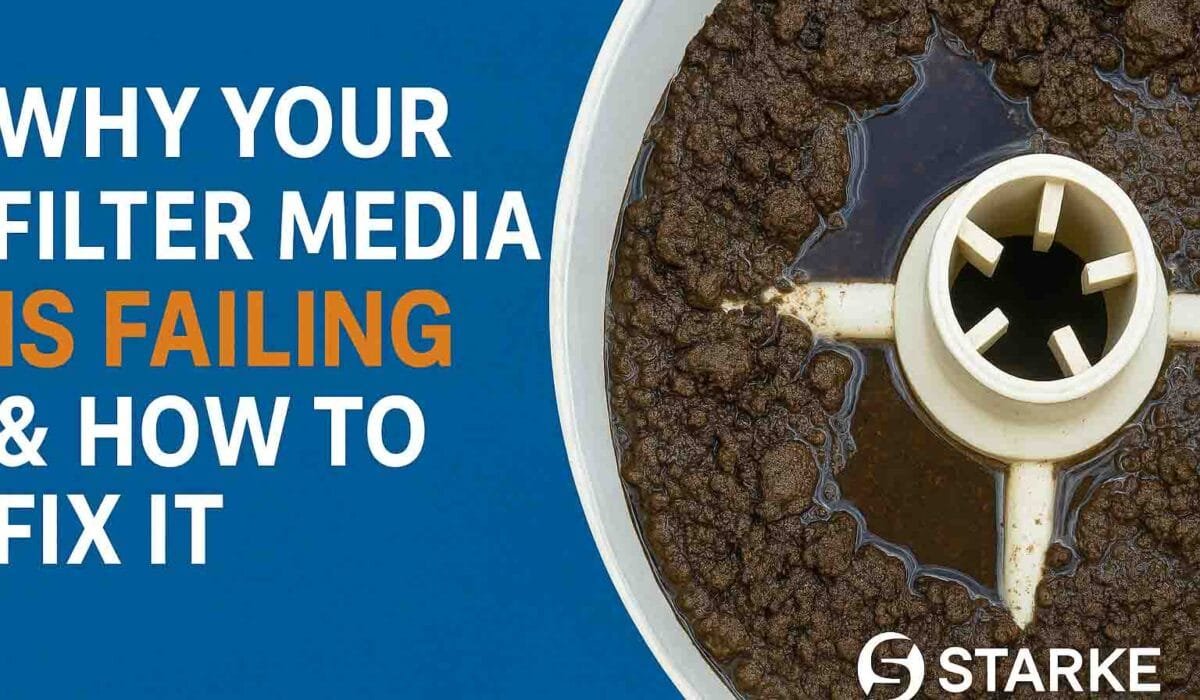Why Your Filter Media Is Failing & How to Fix It
If your filter system is not delivering clean, consistent water your filter media may be the real culprit.
Whether it’s a sewage treatment plant (STP), effluent treatment plant (ETP), or an industrial filtration unit, filter media failure is one of the most overlooked causes of poor performance.
This blog explains why filter media fails, the signs to watch out for, and how to fix or prevent it—based on decades of filtration experience at Starke Filter Media.
Common Reasons Why Filter Media Fails
1. Overloaded with Suspended Solids
Issue: Excessive TSS in the inlet water leads to rapid clogging.
Result: Head loss, poor output quality, short filter runs.
Fix: Install a pre-sedimentation or coarse media layer like gravel or Purozite.
2. Improper Backwashing
Issue: Inadequate or irregular backwash causes media compaction and mudball formation.
Result: Channeling, incomplete filtration.
Fix: Set backwash frequency as per media specs and ensure flow rate is high enough for full bed expansion.
3. Wrong Media Size or Type
Issue: Using incorrect grain size or media incompatible with the water chemistry.
Result: Inefficient removal of iron, turbidity, or organics.
Fix: Consult a filter media specialist like Starke to choose the right media (e.g., MnO₂ for iron, carbon for chlorine, garnet for TSS).
4. Biological Growth & Foul Smell
Issue: Poor maintenance can cause algae or bacteria to grow inside the filter bed.
Result: Foul odor, clogged pores, black sludge.
Fix: Sanitize with chlorine rinse, increase backwash frequency, or use bio-resistant media like anthracite.
5. Expired or Degraded Media
Issue: Using media beyond its functional lifespan.
Result: Sharp drop in performance, color/taste issues, ineffective contaminant removal.
Fix: Refer to media lifespan chart and replace at the right interval.
Typical Media Lifespan Chart
| Filter Media | Lifespan |
|---|---|
| Silica Sand | 3–5 years |
| Activated Carbon | 1–2 years |
| Manganese Dioxide | 5–10 years |
| Purozite | 4–6 years |
| Zeolite | 2–4 years |
| Walnut Shell | 3–4 years |
How to Fix Filter Media Performance Issues
Here’s a quick action plan if your system is underperforming:
✅ Step 1: Conduct a Visual & Physical Media Inspection
Look for compacted or slimy media.
Check for uneven bed height or channeling.
✅ Step 2: Test Filtered Water Output
Measure TSS, turbidity, iron, color, chlorine.
Any spike means your media may be exhausted or clogged.
✅ Step 3: Perform a Trial Backwash
Watch for clarity and media agitation.
If media doesn’t expand evenly, you may have a compaction issue.
✅ Step 4: Replace or Upgrade the Media
Use certified, high-quality media from Starke.
Consider media like Purozite for TSS, Starmnox for iron/manganese, or calcite for pH correction.
Warning Signs You Shouldn’t Ignore
Water output smells like rotten eggs
Rising pressure on pump side
Flow rate reduced by more than 30%
Water has color or suspended solids even after filtration
Ignoring these signs can damage pumps, pipelines, and even downstream processes.
Upgrade Options to Prevent Media Failure
| Problem | Recommended Upgrade |
|---|---|
| Short cycle time | Switch to multi-media layering (garnet + sand + carbon) |
| High TSS | Replace sand with Purozite |
| Iron/Manganese | Use high-purity Starmnox (MnO₂) |
| Bad odor/taste | Add coconut shell activated carbon |
| High oil/grease | Use walnut shell media |
Expert Tip from Starke
Filter media is not one-size-fits-all. What works for one plant may completely fail in another. Always tailor your media choice and maintenance schedule to the water characteristics and system design.
If your filter media is failing, it’s costing you more than just poor water quality. It leads to higher operational costs, reduced equipment life, and compliance risks.
The good news? Most filter media failures are preventable. With the right troubleshooting steps and high-performance media from Starke, your systems can run longer, cleaner, and more efficiently.

